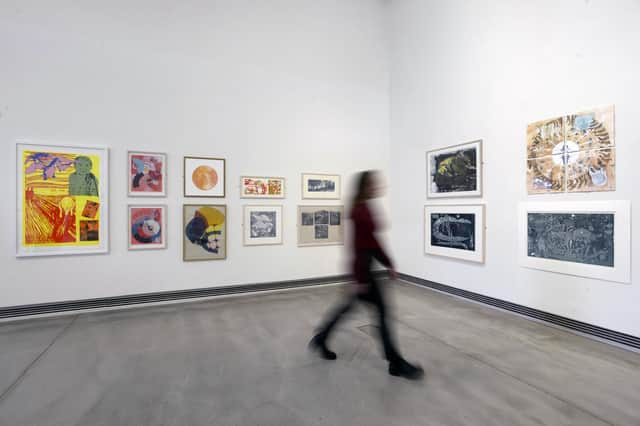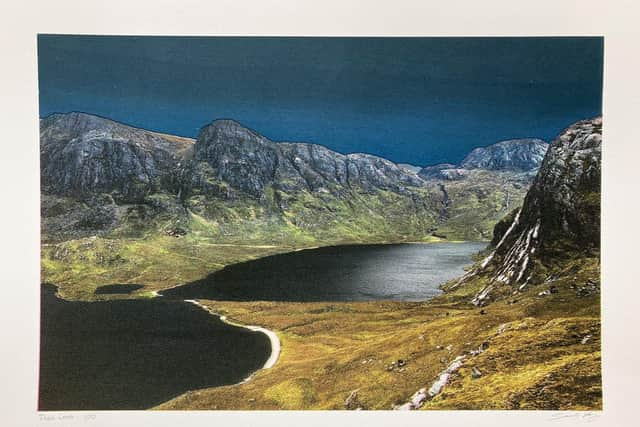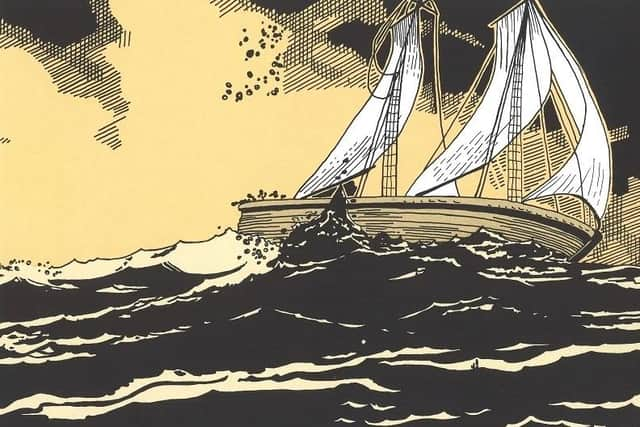Art reviews: Impressions - Scottish Masters of Printmaking | 20th Century Printmaking | Journey: Castle Mills Members' Show 3


Impressions: Scottish Masters of Printmaking, Royal Scottish Academy, Edinburgh ****
20th Century Printmaking, Fine Art Society, Edinburgh ****
Journey: Castle Mills Members' Show 3, Edinburgh Printmakers ***
Advertisement
Hide AdPrintmaking is having a moment. The National Gallery’s current big show, The Printmakers’ Art: Rembrandt to Rego, is a wide historical survey. In the same building, the RSA is showing Impressions: Scottish Masters of Printmaking. Meanwhile, 20th Century Printmaking is at the Fine Art Society and Edinburgh Printmakers is showing Journey, its third annual members’ show. I reviewed the National Gallery show before Christmas. Of the others, Journey at Printmakers is the biggest with around 80 artists represented. The title refers to the workshop’s distinguished history, a journey through time, but it has also journeyed across Edinburgh. The first of the printmakers’ workshops, it was founded in 1967 in Victoria Street. It spent a good many years in a former washhouse in Union Street, then a few years ago moved to its present premises in a former tyre factory near Haymarket.
When it began, it took its place in a long tradition. Several Scottish printmakers were stars in the etching boom that ran from from the late 19th century to the great Crash of 1929. DY Cameron was one of the most distinguished of that generation and at the Fine Art Society his dramatic etching, The Scuir of Eigg, demonstrates just how powerful an etched image can be. Muirhead Bone was another star and, also at the FAS, his Manhattan Excavation, a vivid etching of workers in the deep foundations of a skyscraper in New York, demonstrated emphatically that etching can deal with the modern, industrial world, too. This is equally true of James McBey’s The Moonlight Attack, Jelil. Hanging nearby, it is an etching of kilted soldiers crawling through the grass to attack a Turkish position in the Gallipoli campaign in 1918.
After the market for it collapsed, in Scotland master etcher ES Lumsden was determined to keep etching alive and under his guidance it flourished in the 1930s in the work of younger artists like William Wilson and Ian Fleming. Wilson is represented at the Fine Art Society by a superb print of Ronda, Ian Fleming by several prints of Glasgow during the war and also by a nostalgic image of the late lamented Glasgow School of Art where he taught for many years. Later he moved to Aberdeen, where he played a key role in the creation of Peacock Printmakers.
It was against this continuity that Edinburgh Printmakers was founded. Master printmaker Philip Reeves was a key figure both in this new venture and in the subsequent creation of Glasgow Print Studio. Reeves had come to Scotland in the 1950s to teach printmaking at Glasgow School of Art and was a superb and adventurous printmaker. There are several works by him at the RSA including Fragment 3 one of the most impressive works in all these shows. Described as “Found metal printed in black”, he inked a battered sheet of steel and put it through the press to create a dramatic floating rectangle of richly textured black. That is an unconventional print perhaps, but artists working today certainly still use etching in its classic form. At Edinburgh Printmakers, for instance, Laura Gressani has combined it with monoprint to great effect in Grand and Petit Muveran, Villars, a print of a mountain image with echoes of DY Cameron. Douglas Reed’s picture of a butterfly, Small Purple and Gold, uses coloured etching to create a beautiful image that is both precise and lively. Gordon Williams’ vividly crowded etching of a shop selling bathing costumes in Italy is a delight, too. At the RSA, Adrian Wiszniewski deploys etched line and tonal aquatint to great effect in Highland Mary.


Though etching has status as the favoured medium of some of the greatest artists, there are of course many other ways of making prints. Artists are always making new departures with traditional methods too. One of the most striking images at Printmakers, for instance, is a portrait by Eleanor Buffam done in cyanotype, blueprint in fact, on what appears to be printed silk. Even stranger is Louise Wilde’s dyspraxinoscope, a moving image that seems to be a flat version of the zoetrope, a miniature roundabout which made moving images. The most favoured medium here however is screenprint. Spun off from commercial printing, Eduardo Paolozzi was a leading pioneer in adapting it as an art medium. Avant Garde, a screenprint by him at the Fine Art Society, shows how he enjoyed the anonymous surface that made it so useful commercially. In the Edinburgh Printmakers show, Emily Hogarth uses the flatness of the medium to similar decorative effect in East Lothian Deer. Canach by Jenny Smith is more loosely handled. Reserving white in a field of brushed blue, she creates a lovely image of seed heads. Josef Albers was another pioneer of screen printing and Rhona Taylor has paid elegant homage to him in a series of small screenprints of overlapping squares. Rona MacLean’s Dawn is another beautiful screenprint. At the RSA, John McKechnie uses the medium with great subtlety to describe light on water, but what a true master, or rather mistress, can do with the technique is demonstrated in two lovely prints of flowers by Elizabeth Blackadder at the RSA. Working at Glasgow Print Studio, she made the medium respond to the delicacy of her touch and observation.
Stone lithography might be equated with screenprinting, but Blue Flag Barge by Gavin Johnston, Alastair Clark’s Cello Suite Variations and Alison Grant’s Fool’s Gold, all at Edinburgh Printmakers, demonstrate it is quite distinct with a texture and feeling of directness of touch that screen printing lacks.
Advertisement
Hide AdWoodcut is one of the oldest printing techniques but it is enduring nonetheless. At Printmakers, William Dick uses it to good effect in Maighread I & 2, while at the Fine Art Society, William McCance’s Machine Gods is a traditional woodcut for all its radically modern machine imagery. In the same gallery Charles Mackie’s Bassano Bridge is a masterpiece in the Japanese technique of multiple-block, colour woodcut. Paul Furneaux is a master of this technique. At the RSA he has two lovely examples of it while the late Willie Rodger combines it beautifully with linocut in Sunday, Brighton. Nearby Ade Adesina is showing three magnificent and also enormous woodcuts.
Wood engraving is a variation on woodcut. Printed from the inked flat surface rather than from ink held in the cuts as it is in woodcut proper, it has a fineness and precision that was used to great effect by artists like Agnes Miller Parker, Iain Macnab and Robert Gibbings, all at the Fine Art Society.
Advertisement
Hide Ad

The combinations of technique in printmaking and also the possible variations on traditional methods seem to be endless and a good many more than I can describe are on view in these diverse shows. Monotype, for instance, is really the simplest form of printing and several artists use it here. At Printmakers, for instance, in Twilight Twitters, Fiona Maher combines it with a form of music. It is hanging three-piece composition which she describes as printed with intaglio and monotype on pianola paper, old punched pianola rolls in fact, suspended music.
Impressions: Scottish Masters of Printmaking until 11 February; 20th Century Printmaking until 29 January; Journey: Castle Mills Members' Show 3 until 17 March